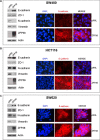Loss of ZFP36 expression in colorectal cancer correlates to wnt/ ß-catenin activity and enhances epithelial-to-mesenchymal transition through upregulation of ZEB1, SOX9 and MACC1
- PMID: 27463018
- PMCID: PMC5312301
- DOI: 10.18632/oncotarget.10828
Loss of ZFP36 expression in colorectal cancer correlates to wnt/ ß-catenin activity and enhances epithelial-to-mesenchymal transition through upregulation of ZEB1, SOX9 and MACC1
Abstract
The mRNA-destabilizing protein ZFP36 has been previously described as a tumor suppressor whose expression is lost during colorectal cancer development. In order to evaluate its role in this disease, we restored ZFP36 expression in different cell contexts, showing that the presence of this protein impairs the epithelial-to-mesenchymal transition (EMT) and induces a higher susceptibility to anoikis. Consistently, we found that ZFP36 inhibits the expression of three key transcription factors involved in EMT: ZEB1, MACC1 and SOX9. Finally, we observed for the first time that its expression negatively correlates with the activity of Wnt/β-catenin pathway, which is constitutively activated in colorectal cancer. This evidence provides a clue on the mechanism leading to the loss of ZFP36 in CRC.
Keywords: ZFP36; colon cancer; epithelial mesenchymal transition; tristetraprolin; β-catenin.
Conflict of interest statement
None.
Figures







References
MeSH terms
Substances
Grants and funding
LinkOut - more resources
Full Text Sources
Other Literature Sources
Medical
Research Materials

